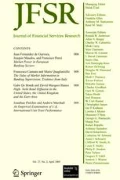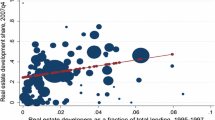Abstract
Cross-country comparisons of average loan interest rates, often carried out using statistics provided by national and international authorities, should be accompanied by strong caveats. If underlying compositional differences in loans, borrowers or lenders are unaccounted for, claims of over/under-pricing may be unfounded. In this paper, we propose a simple methodology that compares interest rates between countries after controlling for such differences. We apply our method to loan-level data from three Irish banks lending to Small and Medium Enterprises (SMEs) in both Ireland and the UK. We find that controlling for such factors reduces the the cross-country interest rate premium significantly. We attribute any remaining interest rate “gap” to overall lending market conditions – for example, to differences in the recoverability of collateral, the level of competition among banks, the aggregate perception of risk, or banks’ expectations on the relative movements in policy rates and exchange rates between the UK and the euro area.

Similar content being viewed by others
Notes
See for example the following quotation from, “SME financing, market innovation and regulation,” Speech by Benoit Coeuré, Member of the Executive Board of the ECB, Eurofi High Level Seminar organised in association with the Irish Presidency of the Council of the EU, Dublin, 11 April 2013: the effectiveness of monetary policy itself has been hindered by financial fragmentation, in particular against the backdrop of a sovereign debt crisis in some euro area jurisdictions. As a result, the accommodative monetary policy stance set by the Governing Council has affected firms rather unevenly.”
Draghi speech: Building the bridge to a stable European economy, at the annual event “Day of the German Industries” organised by the Federation of German Industries, Berlin, 25/9/2012, http://www.ecb.europa.eu/press/key/date/2012/html/sp120925.en.html.
See Berger (2006) for a pre-financial-crisis analysis of the likely competitive effects in SME lending markets of the Basel II capital reforms. He predicts that there were likely to be significant anti-competitive effects from the reforms on large banks not adopting the Advanced Internal Ratings Based approach of Basel II. (Saurina and Trucharte 2004) carry out a similar pre-reform analysis using Spanish credit registry data.
An examination of non-financial corporation lending rates in the UK and Ireland available from national authorities shows a 1.5 percentage point premium in the latter (based on average monthly interest rates in 2015). This comparison is used for illustrative purposes only. The UK rates are sourced from the Bank of England and are a weighted average of “other” loans (“new advances”) up to and including £1 million. Irish rates are sourced from the ECB and are for loans other than revolving loans and overdrafts, convenience and extended credit card debt (“new business”) up to and including €1 million. The differential among loans in our data set is larger than this.
This paper is also discussed in Brewer (2009).
This data is collected by the Central Bank of Ireland and captures all outstanding SME lending at Allied Irish Banks, Bank of Ireland and Permanent TSB on June 30th 2015.
The Primary sector is comprised of agriculture, forestry and fishing.
To protect the confidentiality of the banks submitting the LLD to the Central Bank of Ireland, we do not report sample splits by bank or by internal rating category. Furthermore, within this amortising loans sample, our regressions are not able to control for loan product type as this information is missing for the UK firms.
Assets of three largest commercial banks as a share of total commercial banking assets. Total assets include total earning assets, cash and due from banks, foreclosed real estate, fixed assets, goodwill, other intangibles, current tax assets, deferred tax assets, discontinued operations and other assets.
References
Agarwal S, Hauswald R (2010) Distance and private information in lending. Rev Financ Stud 23(7):2757–2788
Altavilla C, Canova F, Ciccarelli M (2016) Mending the broken link: heterogeneous bank lending and monetary policy pass-through, CEPR Discussion Papers 11584, C.E.P.R. Discussion Papers
Andries N, Billon S (2016) Retail bank interest rate pass-through in the euro area: an empirical survey. Econ Syst 40(1):170–194
Arnold I, van Ewijk S (2014) The impact of sovereign and credit risk on interest rate convergence in the euro area. DNB Working Papers 425, Netherlands Central Bank, Research Department
Beck T, Demirguc-Kunt A, Martinez-Peria MS (2011) Bank financing for SMEs: evidence across countries and bank ownership types. J Financ Serv Res 39(1):35–54
Beck T, Demirguc-Kunt A, Laeven L, Maksimovic V (2006) The determinants of financing obstacles. J Int Money Financ 25(6):932–952
Berger AN (2006) Potential competitive effects of basel II on banks in SME credit markets in the united states. J Financ Serv Res 29(1):5–36
Berger AN, Udell GF (1995) Relationship lending and lines of credit in small firm finance. J Bus 68(3):351–81
Berger AN, Frame WS, Ioannidou V (2011) Tests of ex ante versus ex post theories of collateral using private and public information. J Financ Econ 100(1):85–97
Berger AN, Frame WS, Ioannidou V (2016) Reexamining the empirical relation between loan risk and collateral: the roles of collateral liquidity and types. J Financ Intermed 26:28–46
Bharath ST, Dahiya S, Saunders A, Srinivasan A (2011) Lending relationships and loan contract terms. Rev Financ Stud 24(4):1141–1203
Boot AWA, Thakor AV (1994) Moral hazard and secured lending in an infinitely repeated credit market game. Int Econ Rev 35(4):899–920
Brewer E (2009) Comments on cross-border bank acquisitions: is there a performance effect? J Financ Serv Res 36(2):199–202
Buch CM, Goldberg LS (2015) International banking and liquidity risk transmission: lessons from across countries. IMF Economic Review 63(3):377–410
Carbo-Valverde S, Rodriguez-Fernandez F, Udell G (2009) Bank market power and SME financing constraints. Eur Finan Rev 13(2):309–340
Carroll J, McCann F (2016) Understanding cross-country interest rate variation in Europe. Central Bank of Ireland Quarterly Bulletin 2016(2):60–76
Central Bank of Ireland (2015) SME Market report 2014 H2. https://www.centralbank.ie/publications/documents/SME%20market%20report%202014h2.pdf
Central Bank of Ireland (2016) SME Market report 2015 H2. http://www.centralbank.ie/publications/documents/SME%20market%20report%202015h2.pdf
Correa R (2009) Cross-border bank acquisitions: is there a performance effect? J Financ Serv Res 36(2):169–197
Degryse H, Van Cayseele P (2000) Relationship lending within a bank-based system: evidence from european small business data. J Financ Intermed 9(1):90–109
Degryse H, Ongena S (2005) Distance, lending relationships, and competition. J Financ 60(1):231–266
Dietrich D, Vollmer U (2010) International banking and liquidity allocation. J Financ Serv Res 37(1):45–69
Gambacorta L, Mistrulli PE (2014) Bank heterogeneity and interest rate setting: what lessons have we learned since Lehman brothers? J Money Credit Bank 46(4):753–778
Gianetti M, Laeven L (2012) The flight home effect: evidence from the syndicated loan market during the financial crises. J Financ Econ 104(1):23–43
Harhoff D, Korting T (1998) Lending relationships in Germany - empirical evidence from survey data. J Bank Financ 22(10-11):1317–1353
Hernández-Cánovas G, Martínez-Solano P (2010) Relationship lending and SME financing in the continental European bank-based system. Small Bus Econ 34 (4):465–482
Holton S, d’Acri CR (2015) Jagged cliffs and stumbling blocks: interest rate pass-through fragmentation during the euro area crisis. Research Technical Papers 01/RT/15 Central Bank of Ireland
Holton S, Lawless M, McCann F (2013) SME financing conditions in Europe: credit crunch or fundamentals? Natl Inst Econ Rev 225(1):R52–R67
Mercieca S, Schaeck K, Wolfe S (2009) Bank market structure, competition, and SME financing relationships in european regions. J Financ Serv Res 36(2):137–155
Mudd S (2013) Bank structure, relationship lending and small firm access to finance: a cross-country investigation. J Financ Serv Res 44(2):149–174
Norden L, Weber M (2010) Credit line usage, checking account activity, and default risk of bank borrowers. Rev Financ Stud 23(10):3665–3699
Outreville J (2010) Internationalization, performance and volatility: the world largest financial groups. J Financ Serv Res 38(2):115–134
Paries MD, Moccero D, Krylova E, Marchini C (2014) The retail bank interest rate pass-through: the case of the euro area during the financial and sovereign debt crisis. Occasional Paper Series 155 European Central Bank
Petersen MA, Rajan RG (1994) The benefits of lending relationships: evidence from small business data. J Financ 49(1):3–37
Ryan RM, O’Toole CM, McCann F (2014) Does bank market power affect SME financing constraints? J Bank Financ 49(C):495–505
Santikian L (2014) The ties that bind: bank relationships and small business lending. J Financ Intermed 23(2):177–213
Saurina J, Trucharte C (2004) The impact of basel II on lending to small- and medium-sized firms: a regulatory policy assessment based on spanish credit register data. J Financ Serv Res 26(2):121–144
Sette E, Gobbi G (2015) Relationship lending during a financial crisis. J Eur Econ Assoc 13(3):453–481
Uchida H (2011) What do banks evaluate when they screen borrowers? soft information, hard information and collateral. J Financ Serv Res 40(1):29–48
van Leuvensteijn M, Sorensen CK, Bikker JA, van Rixtel AARJM (2013) Impact of bank competition on the interest rate pass-through in the euro area. Appl Econ 45(11):1359–1380
World Bank (2016) Global financial development database, http://www.worldbank.org/en/publication/gfdr/data/global-financial-development-database
Author information
Authors and Affiliations
Corresponding author
Appendix
Appendix
Rights and permissions
About this article
Cite this article
McCann, F., Carroll, J. Observables and Residuals: Exploring Cross-Border Differences in SME Borrowing Costs. J Financ Serv Res 56, 167–184 (2019). https://doi.org/10.1007/s10693-017-0285-2
Received:
Revised:
Accepted:
Published:
Issue Date:
DOI: https://doi.org/10.1007/s10693-017-0285-2




